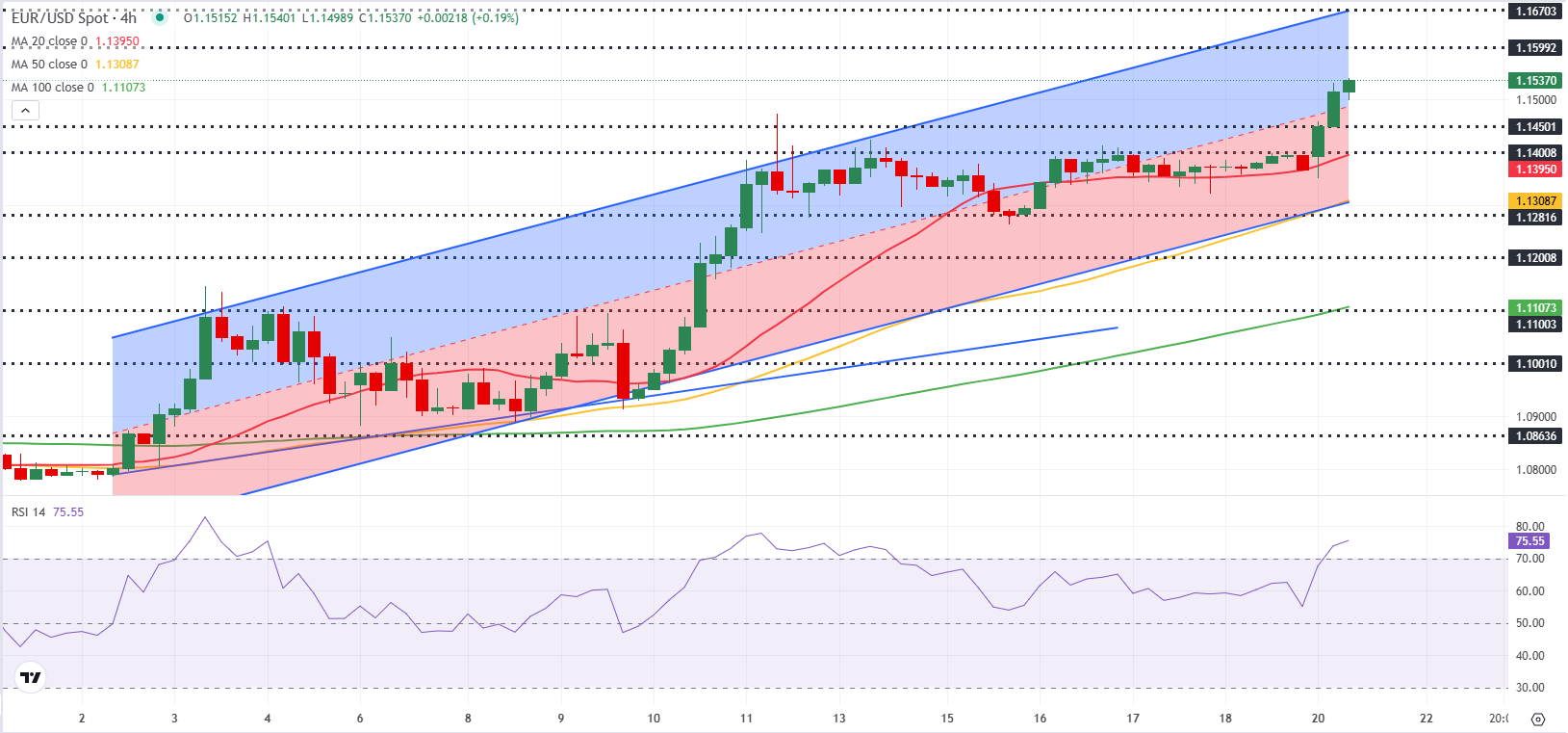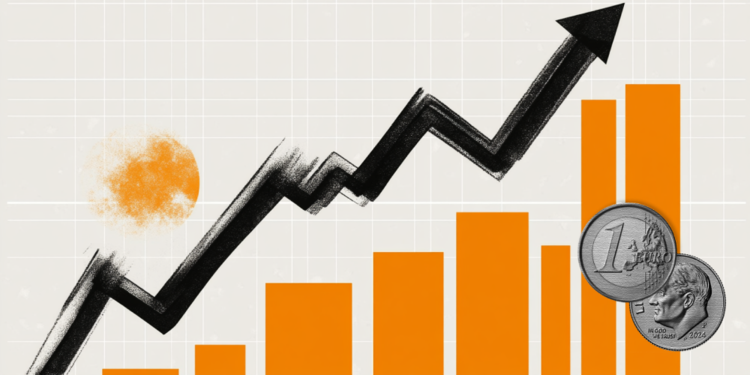- EUR/USD trades above 1.1500 for the first time since November 2021.
- The technical outlook points to overbought conditions in the near term.
- The US Dollar stays under persistent selling pressure to start the week.
EUR/USD gathers bullish momentum on Monday and trades at its highest level since November 2021 above 1.1500, gaining over 1% on a daily basis. The pair’s technical outlook points to overbought conditions but the broad-based selling pressure surrounding the US Dollar (USD) could cause investors to refrain from betting on a deep correction.
Euro PRICE Today
The table below shows the percentage change of Euro (EUR) against listed major currencies today. Euro was the strongest against the US Dollar.
| USD | EUR | GBP | JPY | CAD | AUD | NZD | CHF | |
|---|---|---|---|---|---|---|---|---|
| USD | -1.27% | -0.79% | -1.05% | -0.37% | -0.80% | -1.39% | -1.28% | |
| EUR | 1.27% | 0.33% | 0.19% | 0.87% | 0.28% | -0.16% | -0.03% | |
| GBP | 0.79% | -0.33% | 0.02% | 0.55% | -0.05% | -0.49% | -0.36% | |
| JPY | 1.05% | -0.19% | -0.02% | 0.70% | 0.13% | -0.23% | -0.18% | |
| CAD | 0.37% | -0.87% | -0.55% | -0.70% | -0.56% | -1.03% | -0.89% | |
| AUD | 0.80% | -0.28% | 0.05% | -0.13% | 0.56% | -0.43% | -0.31% | |
| NZD | 1.39% | 0.16% | 0.49% | 0.23% | 1.03% | 0.43% | 0.16% | |
| CHF | 1.28% | 0.03% | 0.36% | 0.18% | 0.89% | 0.31% | -0.16% |
The heat map shows percentage changes of major currencies against each other. The base currency is picked from the left column, while the quote currency is picked from the top row. For example, if you pick the Euro from the left column and move along the horizontal line to the US Dollar, the percentage change displayed in the box will represent EUR (base)/USD (quote).
Heightened concerns over the United States’ trade policy triggering an economic downturn and growing uncertainty about the Federal Reserve’s (Fed) independency weigh heavily on the USD on Monday.
While speaking to reporters late Friday, White House economic adviser Kevin Hassett said President Donald Trump and his team were continuing to study if firing Fed Chairman Jerome Powell was an option in a way that it wasn’t before. Meanwhile, a spokesperson for the Chinese Commerce Ministry said that China will take countermeasures against countries that make a deal with the US at the expense of their interests.
Reflecting the USD weakness, the USD Index was last seen losing more than 1% on the day below 98.20.
Many major international markets, including Germany, France and the UK, will remain closed in observance of the Easter Monday holiday but US stock and bond markets will operate at regular hours. The US economic calendar will not feature any high-tier data releases. In the meantime, US stock index futures lose about 1% in the European morning. The USD has been struggling to benefit from risk-aversion lately, suggesting that the currency is unlikely to benefit from a selloff in Wall Street.
EUR/USD Technical Analysis

The Relative Strength Index (RSI) indicator on the 4-hour chart rose above 70, reflecting overbought conditions for EUR/USD. On the downside, 1.1500 (mid-point of the ascending channel) aligns as first support before 1.1450 (static level) and 1.1400 (20-period Simple Moving Average).
Looking north, first resistance could be spotted at 1.1600 (static level, round level) ahead of 1.1670 (upper limit of the ascending channel).
Euro FAQs
The Euro is the currency for the 19 European Union countries that belong to the Eurozone. It is the second most heavily traded currency in the world behind the US Dollar. In 2022, it accounted for 31% of all foreign exchange transactions, with an average daily turnover of over $2.2 trillion a day.
EUR/USD is the most heavily traded currency pair in the world, accounting for an estimated 30% off all transactions, followed by EUR/JPY (4%), EUR/GBP (3%) and EUR/AUD (2%).
The European Central Bank (ECB) in Frankfurt, Germany, is the reserve bank for the Eurozone. The ECB sets interest rates and manages monetary policy.
The ECB’s primary mandate is to maintain price stability, which means either controlling inflation or stimulating growth. Its primary tool is the raising or lowering of interest rates. Relatively high interest rates – or the expectation of higher rates – will usually benefit the Euro and vice versa.
The ECB Governing Council makes monetary policy decisions at meetings held eight times a year. Decisions are made by heads of the Eurozone national banks and six permanent members, including the President of the ECB, Christine Lagarde.
Eurozone inflation data, measured by the Harmonized Index of Consumer Prices (HICP), is an important econometric for the Euro. If inflation rises more than expected, especially if above the ECB’s 2% target, it obliges the ECB to raise interest rates to bring it back under control.
Relatively high interest rates compared to its counterparts will usually benefit the Euro, as it makes the region more attractive as a place for global investors to park their money.
Data releases gauge the health of the economy and can impact on the Euro. Indicators such as GDP, Manufacturing and Services PMIs, employment, and consumer sentiment surveys can all influence the direction of the single currency.
A strong economy is good for the Euro. Not only does it attract more foreign investment but it may encourage the ECB to put up interest rates, which will directly strengthen the Euro. Otherwise, if economic data is weak, the Euro is likely to fall.
Economic data for the four largest economies in the euro area (Germany, France, Italy and Spain) are especially significant, as they account for 75% of the Eurozone’s economy.
Another significant data release for the Euro is the Trade Balance. This indicator measures the difference between what a country earns from its exports and what it spends on imports over a given period.
If a country produces highly sought after exports then its currency will gain in value purely from the extra demand created from foreign buyers seeking to purchase these goods. Therefore, a positive net Trade Balance strengthens a currency and vice versa for a negative balance.

